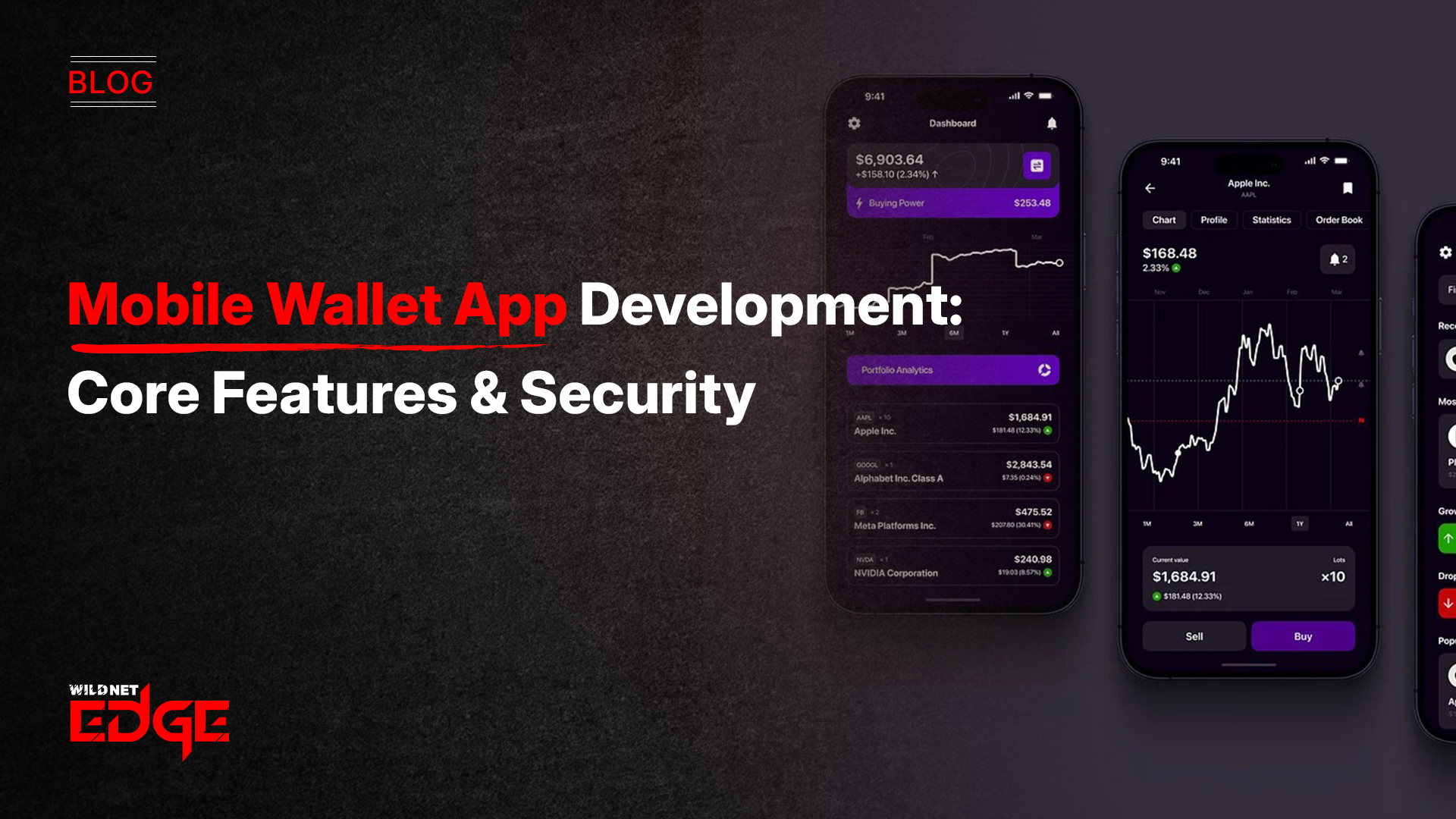Struggling to keep up with the fast-evolving digital payment landscape? Mobile wallet apps are no longer optional—they’re essential. But what makes a mobile wallet app stand out in terms of features and security? In this guide, we’ll break down the core elements, including NFC payments and digital KYC integration, that ensure your app is not just functional but trusted. Let’s dive into the must-haves for mobile wallet app development that can transform how users pay and protect their data.
NFC Payments in Mobile Wallet Apps
Near Field Communication (NFC) technology has become a game-changer in the way mobile wallets facilitate payments. At its core, NFC is a wireless communication technology that enables devices to exchange information when they come within a few centimeters of each other, making it ideal for contactless transactions.
What is NFC (Near Field Communication) technology?
NFC allows your smartphone to communicate with payment terminals or other NFC-enabled devices instantly and securely. Unlike Bluetooth or Wi-Fi, NFC requires no pairing or manual setup, simplifying the user experience dramatically.
How NFC enables contactless, quick transactions
When a user taps their phone near an NFC-enabled payment terminal, encrypted payment data—such as credit card information stored securely in the wallet app—is transmitted in milliseconds. This speed and ease reduce queues and increase checkout efficiency, particularly in retail, transit, and hospitality sectors.
Benefits of integrating NFC payments for users and businesses
- Convenience: Users can make fast payments without carrying physical cards or cash.
- Security: NFC transactions utilize tokenization and encryption that minimize fraud risks.
- Hygiene: Encourages contactless payments, vital in health-conscious environments.
- User Engagement: Businesses can offer personalized offers or loyalty rewards integrated with NFC functions.
- Competitive Edge: Early NFC adoption can improve brand reputation and customer satisfaction.
Steps to implement NFC payments in your app development process
- Choose NFC-compatible hardware: Ensure devices and payment terminals support NFC standards like ISO/IEC 14443.
- Integrate NFC APIs and SDKs: Use platform-specific APIs (e.g., Android’s NFC API, Core NFC for iOS) for communication handling.
- Implement tokenization: Replace sensitive card data with tokens to enhance security during NFC data exchange.
- Certify with payment networks: Partner with payment gateways (Visa, Mastercard, etc.) and comply with PCI-DSS standards.
- Test rigorously: Validate functionality across different devices, OS versions, and real-world scenarios.
Challenges and security considerations with NFC technology
While NFC payments enhance user experience, developers must address challenges like:
- Eavesdropping risks: Although short range limits exposure, encrypted data transmission is crucial to thwart interception.
- Relay attacks: Attackers could intercept and relay communication; anti-relay technology and proximity checks help prevent this.
- Device compatibility: Not all smartphones or payment terminals support NFC equally, demanding broad compatibility testing.
- User privacy: Transparent data policies and minimal data storage practices ensure compliance with privacy regulations.
By mastering NFC integration and security nuances, your mobile wallet app will provide seamless, secure payments that users trust daily.
Digital KYC Integration for User Verification
Integrating digital KYC (Know Your Customer) processes into mobile wallet apps is vital in the current regulatory environment and for bolstering user trust through verified identities.
Why digital KYC is critical for compliance and security
Governments and financial institutions mandate KYC to prevent identity fraud, money laundering, and financing of unlawful activities. Digital KYC automates standard verification steps, ensuring your app complies with Anti-Money Laundering (AML) laws and the latest FinTech regulations while maintaining operational efficiency.
Methods and tools used for seamless digital KYC verification
Contemporary digital KYC solutions leverage:
- Document OCR and verification: Scanning ID cards, passports, or driving licenses with Optical Character Recognition technology.
- Facial recognition & liveness detection: Matching selfies or live video to the ID document to confirm authenticity and rule out spoofing.
- Biometric authentication: Fingerprints or iris scan integration adds layers of identity assurance.
- AI-based data validation: Algorithms analyze user input and cross-check against databases for fraud prevention.
- Third-party KYC APIs: Providers like Onfido, Jumio, or Shufti Pro offer modular SDKs for easy integration.
Impact of digital KYC on user onboarding experience
Digital KYC reduces the time and friction traditionally associated with onboarding:
- Users can complete verification within minutes, without visiting a physical branch.
- Automated checks minimize manual errors and rejections.
- Real-time feedback prompts users if additional info or clearer documents are needed.
Thanks to these enhancements, apps report up to 40% higher conversion rates from installation to active use.
Balancing strict security and user convenience
High security mustn’t come at the expense of usability. To strike this balance:
- Use progressive profiling—requesting essential information first and additional details later if necessary.
- Provide clear, concise instructions during the verification step.
- Allow alternative authentication methods for users facing tech limitations.
- Ensure transparency about data use to build trust.
Examples of digital KYC integration frameworks and APIs
- Onfido: Combines ID verification with biometric facial checks.
- Jumio: Offers identity verification, KYB, and AML screening.
- Shufti Pro: Provides multi-layered KYC with global document support.
Incorporating such APIs accelerates your development and ensures access to cutting-edge compliance tech essential for mobile wallet app security.
Core Features of a Mobile Wallet App
Building a secure and competitive mobile wallet app requires incorporating features beyond just NFC and KYC. These functionalities collectively create a seamless payment ecosystem users rely on daily.
Secure user authentication (biometric, PIN, multi-factor)
Robust authentication mechanisms protect user accounts from unauthorized access. Common practices include:
- Biometric authentication: Fingerprint, Face ID, or iris scanning for quick yet secure logins.
- PIN codes: A fallback method providing simple security, especially on devices lacking biometric sensors.
- Multi-factor authentication (MFA): Combining passwords, OTPs, and biometrics for layered protection.
Transaction history and real-time notifications
Offering users transparency over their finances:
- Clear, detailed transaction logs with timestamps and merchant info.
- Real-time push notifications for every transaction, top-up, or bill payment enhance trust and allow users to instantly spot suspicious activities.
Wallet top-up and fund transfer capabilities
Essential functionality to maintain app utility:
- Multiple funding sources, including linked bank accounts, credit/debit cards, or direct bank transfers.
- Peer-to-peer transfers via phone numbers, email, or QR codes expand app versatility.
- Integration with major payment protocols and regional payment schemes (like UPI in India or SEPA in Europe) supports broader user demographics.
Bill payments, loyalty programs, and rewards integration
Adding value beyond payments solidifies user engagement:
- Enable utility, telecom, and other bill payments directly within the app.
- Loyalty programs tied to spending patterns encourage repeat use.
- Integration with rewards platforms boosts customer retention by offering points, cashback, or coupons.
User-friendly UI/UX design considerations
Even the most secure and feature-rich wallet fails without intuitive design:
- Minimalist and clean interface to simplify navigation.
- Accessibility features accommodating users with disabilities.
- Fast load times and offline capabilities in areas with unstable internet.
- Clear onboarding tutorials and contextual help to ease first-time user challenges.
Advanced Security Practices and Future Trends
Security remains a moving target; thus, staying ahead with advanced measures and adopting emerging trends is vital for long-term success.
Data encryption and tokenization strategies
All sensitive data stored or transmitted must be protected through:
- End-to-end encryption: Ensures data remains unreadable during transmission.
- Tokenization: Replaces sensitive details (e.g., card numbers) with non-sensitive tokens used in transactions to reduce breach impact.
- Secure Enclave & Trusted Execution Environments (TEE): Device-level security zones prevent unauthorized data extraction.
Fraud detection and risk management tools
Modern mobile wallet apps leverage AI and machine learning tools that:
- Analyze transaction patterns for anomalies indicating potential fraud.
- Employ real-time risk scoring before approving transactions.
- Alert users and admins proactively if suspicious activities are detected.
AI-driven security algorithms and behavioral analytics
New frontiers in security include:
- Behavioral biometrics analyzing typing speed, device handling, and location patterns.
- Adaptive authentication changing security levels dynamically based on risk profiles.
- Chatbots and virtual assistants detect and respond to threats, enhancing incident response time.
Evolution of digital identity verification beyond traditional KYC
Digital identity is evolving toward decentralized models:
- Self-sovereign identity (SSI): Allows users to control and selectively share identity attributes without centralized storage.
- Leveraging verifiable credentials on blockchain networks supports privacy-preserving verification models.
- Governments and enterprises increasingly support these standards ensuring interoperability.
The growing role of blockchain for transparency and security
Blockchain technology offers:
- Immutable transaction records, reducing fraud and enabling audits.
- Smart contracts automating payments upon verified conditions.
- Enhanced user control over digital assets within the mobile wallet, facilitating cross-border and cross-platform interoperability.
Embracing these advancements positions your mobile wallet app at the forefront of innovation and trustworthiness.
Conclusion
Developing a mobile wallet app that effectively combines NFC payments, digital KYC integration, and robust security features is key to staying competitive and trusted in today’s digital economy. WildnetEdge offers expert app development services tailored to these demands, ensuring your mobile wallet is not only feature-rich but also secure and compliant. Ready to build a next-gen mobile wallet app? Partner with WildnetEdge and transform your digital payment experience.
FAQs
Q1: What are the benefits of NFC payments in mobile wallet apps?
NFC payments provide fast, contactless transactions, enhance user convenience, and increase security by enabling encrypted communication between devices.
Q2: How does digital KYC integration improve mobile wallet security?
Digital KYC verifies user identity through automated, real-time checks, reducing fraud risk and ensuring compliance with regulatory standards.
Q3: What core features should a secure mobile wallet app include?
Essential features include strong user authentication, transaction history, fund transfers, real-time alerts, and intuitive UI/UX design.
Q4: How can developers ensure data security in mobile wallet apps?
By implementing encryption, tokenization, multi-factor authentication, fraud detection tools, and keeping software updated against vulnerabilities.
Q5: What future trends will impact mobile wallet app development?
Trends include AI-based security, blockchain integration, enhanced digital identity solutions, and deeper NFC adoption for broader payments ecosystems.

Nitin Agarwal is a veteran in custom software development. He is fascinated by how software can turn ideas into real-world solutions. With extensive experience designing scalable and efficient systems, he focuses on creating software that delivers tangible results. Nitin enjoys exploring emerging technologies, taking on challenging projects, and mentoring teams to bring ideas to life. He believes that good software is not just about code; it’s about understanding problems and creating value for users. For him, great software combines thoughtful design, clever engineering, and a clear understanding of the problems it’s meant to solve.
 sales@wildnetedge.com
sales@wildnetedge.com +1 (212) 901 8616
+1 (212) 901 8616 +1 (437) 225-7733
+1 (437) 225-7733































